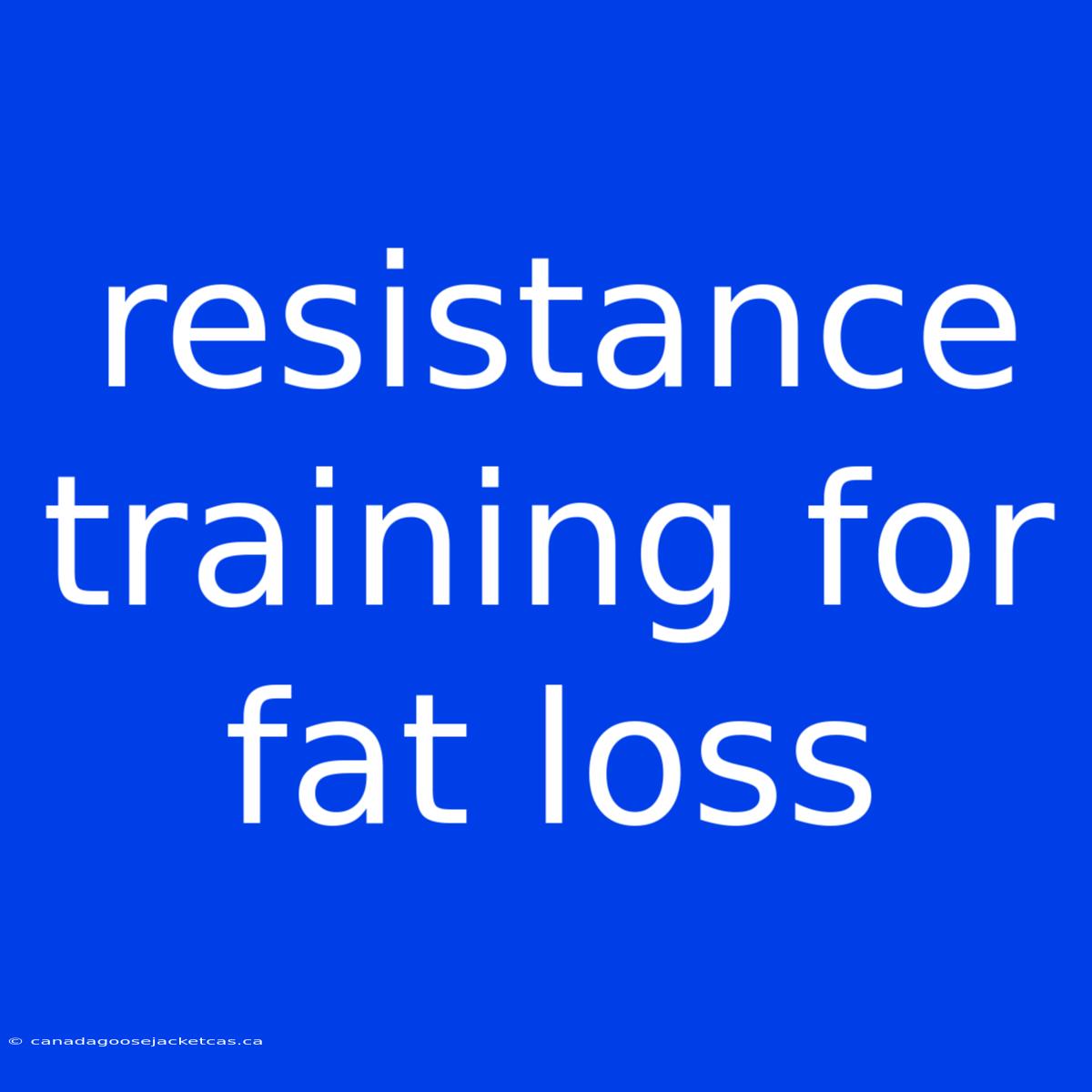Resistance Training for Fat Loss: Unlocking Your Body's Fat-Burning Potential
Is resistance training truly effective for fat loss? The answer is a resounding yes! Resistance training is not only about building muscle, but also about accelerating your metabolism and boosting your body's ability to burn fat.
Editor's Note: This article explores the powerful connection between resistance training and fat loss, revealing why it's a crucial component of a successful weight management strategy.
Why is this topic so important? Understanding the benefits of resistance training for fat loss can empower you to make informed decisions about your fitness journey. This knowledge can help you achieve your weight goals more effectively and efficiently.
Our analysis has delved into scientific studies, expert opinions, and real-world success stories. We've meticulously examined the mechanisms behind resistance training's fat-burning power and distilled the key takeaways into a comprehensive guide for you.
Key Takeaways of Resistance Training for Fat Loss
| Benefit | Description |
|---|---|
| Increased Metabolism | Resistance training boosts your metabolic rate, leading to more calories burned even at rest. |
| Muscle Growth | More muscle mass translates to a higher calorie-burning baseline, even when you're not exercising. |
| Improved Insulin Sensitivity | Resistance training enhances insulin sensitivity, helping your body regulate blood sugar levels and reducing fat storage. |
| Increased Fat Oxidation | Resistance training promotes fat oxidation, meaning your body burns more fat for fuel. |
Resistance Training for Fat Loss: The Essential Aspects
This section dives deeper into the key aspects of resistance training for fat loss. We'll explore the benefits of different training styles, exercise selection, and strategies to maximize your results.
Benefits of Different Training Styles
High-Intensity Interval Training (HIIT): HIIT involves alternating periods of intense effort with short recovery periods. It's proven to be highly effective for fat loss, boosting your metabolism and improving cardiovascular health.
Circuit Training: Circuit training involves performing a series of exercises with little rest between sets. This approach keeps your heart rate elevated, maximizes calorie burn, and builds muscle efficiently.
Strength Training: Focuses on lifting heavy weights for fewer repetitions. This method enhances muscle mass and strength, leading to a higher calorie-burning rate even at rest.
Exercise Selection
The best exercises for fat loss are those that engage large muscle groups and promote calorie expenditure. Some excellent examples include:
- Squats: Targets the legs, glutes, and core.
- Deadlifts: Engages the entire posterior chain, including the back, glutes, and hamstrings.
- Push-ups: Works the chest, shoulders, and triceps.
- Pull-ups: Targets the back and biceps.
- Lunges: Strengthens the legs, glutes, and core.
- Plank: Works the core muscles for stability and strength.
Maximizing Fat Loss
To optimize your results, consider these strategies:
- Progressive Overload: Gradually increase the weight, sets, or repetitions over time to challenge your muscles and keep them growing.
- Proper Nutrition: Pair your resistance training with a balanced and calorie-controlled diet to support muscle growth and fat loss.
- Rest and Recovery: Allow your muscles time to recover between workouts to prevent injury and promote growth.
FAQ - Resistance Training for Fat Loss
Q: How often should I do resistance training for fat loss? A: Aim for 2-3 resistance training sessions per week, with at least one day of rest between workouts.
Q: Can I lose weight without resistance training? A: You can lose weight through cardio exercises alone, but resistance training is crucial for building and maintaining muscle mass, which is vital for boosting your metabolism and long-term fat loss success.
Q: Can I do resistance training at home? A: Absolutely! There are numerous bodyweight exercises you can do at home, using resistance bands, or even household objects.
Q: How long will it take to see results? A: The timeframe for seeing results varies depending on individual factors like genetics, starting point, and consistency. However, you should start to notice changes in your body composition and energy levels within a few weeks.
Q: Should I focus on fat loss or muscle gain? A: The best approach is to focus on both. By building muscle, you'll automatically boost your metabolism, making it easier to lose fat.
Tips for Resistance Training for Fat Loss
- Start Gradually: Begin with a manageable weight and gradually increase it as you get stronger.
- Focus on Proper Form: Prioritize technique over heavy weights to avoid injury and maximize muscle activation.
- Listen to Your Body: Pay attention to your body's signals and take rest days when needed.
- Challenge Yourself: Don't be afraid to step outside of your comfort zone and try new exercises or increase the intensity.
- Stay Consistent: The key to success is consistency. Make resistance training a regular part of your fitness routine.
Resistance Training for Fat Loss: A Journey of Strength and Transformation
In conclusion, resistance training plays a vital role in achieving and maintaining long-term fat loss. It boosts your metabolism, increases muscle mass, improves insulin sensitivity, and promotes fat oxidation.
By incorporating resistance training into your fitness plan, you can unlock your body's fat-burning potential and embark on a journey of strength and transformation. Remember, consistency and a holistic approach that includes proper nutrition and rest are essential for optimal results.

